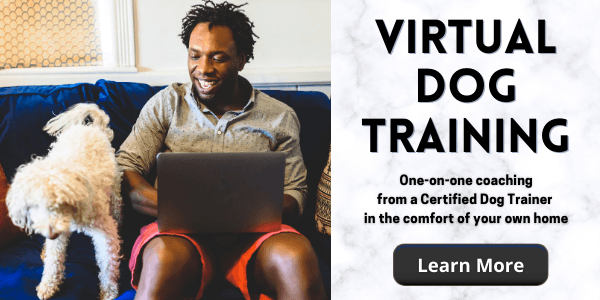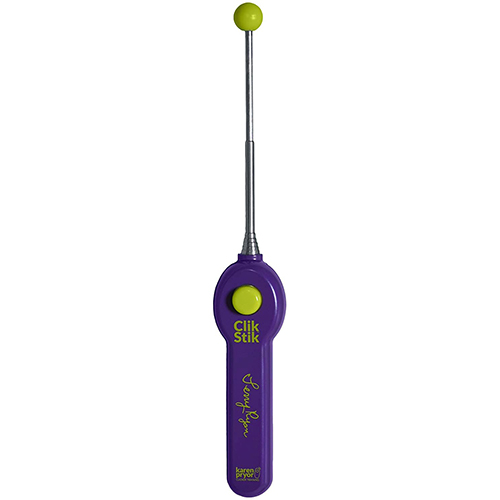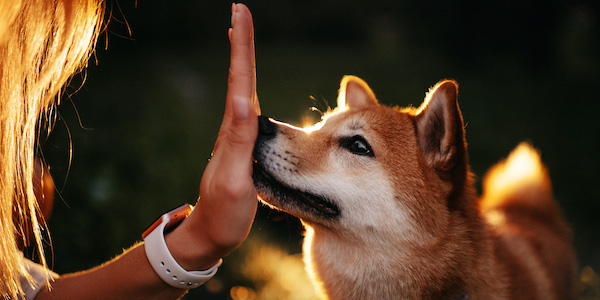 Teaching a dog how to touch their nose to a target is one of the first things I train. Why? Targeting can be used as a foundation for so many behaviors that we want our dogs to learn, from walking nicely on a leash to coming when called.
Teaching a dog how to touch their nose to a target is one of the first things I train. Why? Targeting can be used as a foundation for so many behaviors that we want our dogs to learn, from walking nicely on a leash to coming when called.
It's also a favorite of mine to use when practicing handling and skills that your dog will need when they're at the veterinarian or getting professionally groomed.
Teaching a dog to "touch" is also a great beginning behavior for us humans to practice our training skills and timing. And because it's so easy, I love starting with it because both dogs and humans feel successful from the get-go! Learn how to teach your dog to touch your hand when asked by following the steps below.
How to Train Your Dog to Touch a Hand Target
What You'll Need:
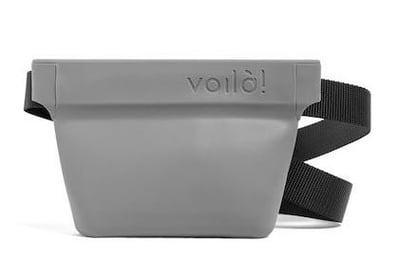 A training treat pouch. My favorite and the one I use the most is the Voilà Ultimate Treat Pouch. It's high-grade silicone, which makes it easy to wash and perfect for the fresh high-value dog treats I use the most. Use code PV10 to get 10% off!
A training treat pouch. My favorite and the one I use the most is the Voilà Ultimate Treat Pouch. It's high-grade silicone, which makes it easy to wash and perfect for the fresh high-value dog treats I use the most. Use code PV10 to get 10% off!- Your clicker (or marker word like "yes!" if you're not using a clicker)
- Your dog's favorite training treats (like these Zuke's Mini Naturals training treats or low-fat string cheese or turkey hotdogs cut up into tiny pieces.
Teaching Your Dog to Target Your Hand
Introducing a Hand Target
- Have a treat ready in a closed fist behind your back. Use the opposite hand as your beginning target.
- Hold your target hand out sideways with your palm open and your fingers flat.
- Place your open palm close to your dog's nose. Most dogs will instinctually want to sniff it.
- Once you feel the contact of their nose on your hand (even if it's just a brush of their whiskers), click or say "yes!" and give the treat from the other hand.
- Repeat!
PRO TIP: Mix up which hand you're using as the target.
This beginning step is meant to be easy for your dog to figure out and be successful. Keep your target hand really close to your dog's nose at first. This way they'll get more successful repetitions and learn the association quickly. Don't worry about saying anything quite yet. You presenting your open hand as a target is your dog's cue to touch.
Adding in Distance for a Hand Target
- Once your dog is easily and intentionally touching their nose to your hand when it's close to their face, begin holding it a bit further away.
- Increase the distance by an inch or two at first.
- When you feel their nose on your palm, click or say "yes!" and give them a treat.
- Move your hand to the other side of their face and repeat.
- As you practice, increase and decrease the distance they have to move to touch your hand target.
Once your dog gets the hang of having to take a small step to touch your hand, you can increase the criteria for this cue. Increasing cue criteria means you're "raising the bar" for your dog. Instead of having to only take a small step, now they have to take two steps! Or maybe they have to turn around to touch the hand target behind them. Play around with different distances and positions during each short and sweet training session.
Adding a Verbal Cue for a Hand Target
Once your dog is reliably touching your target hand when you present it and from varying distances, you can then add the verbal cue to this behavior.
- Present your hand as you have been doing in previous steps.
- Say "touch."
- Click and treat when they touch your target hand.
- Repeat!
With repetition, your dog will learn that the word "touch" means to find that target hand. This step is helpful when using the touch cue as a come-when-called alternative or when using it to redirect attention from distractions. Watch trainer Laurie Luck demonstrate these steps in this video:
Touch Cue Troubleshooting
What Do You Do When Your Dog Doesn't Want to Touch (or Avoids) the Hand Target?
If your dog just isn't showing interest in your hand target, try moving it a bit closer to them or wiggling your fingers to entice them to sniff it.
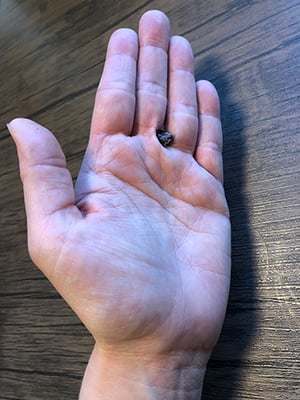 You can also place a treat in between your fingers (right where your fingers meet your palm) to give your dog a delicious smelling target. See the inset photo of this treat lure placement.
You can also place a treat in between your fingers (right where your fingers meet your palm) to give your dog a delicious smelling target. See the inset photo of this treat lure placement.
TRAINING TIP: Don't give them the treat that's between your fingers. Keep treating from the opposite hand as this will make fading out the treat target easier.
If your dog seems fearful of your hand, you'll want to counter condition the presence of a hand close to their face and body. You'll want to go back a few steps and start building a positive association with your dog just seeing your hand and receiving a treat or other positive reinforcement.
Consider working with a certified dog behavior consultant to develop a counter conditioning plan, as this can be very helpful for building a dog's confidence and overcoming fear.
Can You Use a Different Hand Position for the Target?
Yes — there's no rule that your hand target needs to be an open palm with flat fingers! For some dogs, this hand position can be confused with their shake or high-five cue. Many of my clients will instead use a closed fist as a hand target and call it "nose bump."
An open palm might also be overwhelming for toy breeds. You could use just one or two fingers as their hand target instead.
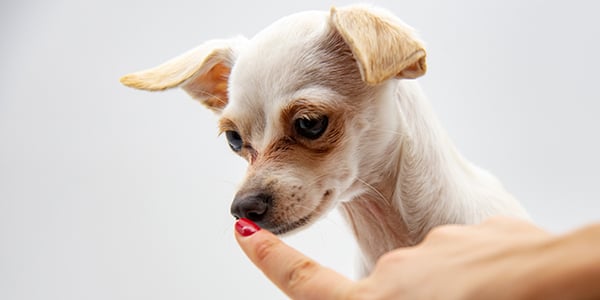
Can You Teach Your Dog to Target Things Other Than Your Hand?
Definitely! I love transferring this touch cue to different objects. It's especially useful when teaching your puppy how to use potty bells or using floor targets during agility training. The first target I train after mastering the hand target with a dog is a target stick. My favorite is the Clik Stik, which has a built-in clicker (because I don't have three hands) and can be extended to various lengths. It's a fantastic tool for practicing heeling with your dog.
Watch Finnegan, a recent puppy addition to the Preventive Vet office, start to practice with his Clik Stik in this video:
Target sticks can be used for all kinds of animals! Zookeepers use these target sticks extensively in their training and enrichment programs for the animals they care for, from tigers to Galapagos tortoises. It's especially helpful in being able to do wellness checks and help them move animals from one place to another without force. Check out this cool video of target training with a Cape Porcupine at the North Carolina Zoo:
When Should You Use the Touch Cue With Your Dog?
Because of this cue's simplicity, it's incredibly useful in a variety of situations! Here are a few ideas:
Preventing Pulling On Leash
You can use the touch cue to prevent your dog from pulling on leash or to reset them into the correct heel position if they started to pull. If you notice they're about to hit the end of the leash, ask them for a touch with the hand target right next to your body. Reward them by going with them to sniff or check out whatever it was they were about to pull towards (as long as it's safe and appropriate).
Preventing Jumping Up on People in Greeting
Touch is a great alternative behavior to teach a dog to do when greeting people. One client of mine put this behavior on the verbal cue of "say hi," and her dog would gently nudge someone's hand in greeting before returning to her for a treat or praise. Practice first teaching your dog to touch your outstretched hand before practicing with other people. Once they touch someone's hand in greeting, toss a treat on the ground to further prevent jumping up on people in excitement. If they're too busy sniffing out their treat on the floor, they won't be jumping up!
As a Come-When-Called Alternative
While you are working on building up your dog's come-when-called behavior, the touch cue is great in the meantime! If you want to use the cue this way, practicing adding distance to the behavior is essential. Work on targeting your hand from a few feet away, then across the room. Once this is reliable, practice calling your dog to "touch!" when you're in a different room, or from across the yard!
Putting on Harnesses
Using a hard target can make getting your dog into their harness easier for everyone. It's especially useful for over-the-head style harnesses, as many dogs might shy away or just be too wiggly to easily put their harness on. Hold the harness so there's space for them to reach their head through and hold your hand target just beyond it. This way they'll learn to put their head through the harness for you. Start easy with this to build confidence (especially for dogs that are head shy around harnesses).
Distraction for Leash Reactive Dogs
When working with a dog that barks or lunges when they see other people or dogs while on leashed walks, having a simple cue like touch can be helpful for when they need a distraction from their "trigger." Asking a dog with reactive behavior to focus on touching a hand target, instead of staring at the approaching dog or person, keeps their brain engaged and busy — often preventing them from going over threshold and reacting inappropriately. Having a touch cue also helps move these dogs to farther distances from other people or dogs when they find themselves unexpectedly close. See a client of mine use Touch with her dog Gunther during leash reactivity practice:
With reactive behavior such as barking or lunging while on leash, finding a certified dog trainer or dog behavior consultant will help you learn how to effectively manage distance from your dog's trigger, how to countercondition their negative emotional reaction and teach you how to use basic cues like touch to your advantage in more advanced behavior work.
What do you use your dog's touch cue for the most? Let us know in the comments below!
